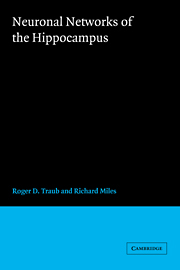Book contents
- Frontmatter
- Contents
- Acknowledgments
- Prologue
- 1 The hippocampus in context
- 2 Physiology of single neurons: voltage- and ligand-gated ionic channels
- 3 Synaptic function and organization of the CA3 region
- 4 The single-cell model
- 5 Model of the CA3 network
- 6 Collective behaviors of the CA3 network: experiment and model
- 7 Collective behaviors of the CA3 network: spontaneous oscillations and synchronized synaptic potentials
- 8 Field effects
- 9 Theoretical approaches: mathematical neural networks
- Conclusion
- Notes
- References
- Index
4 - The single-cell model
Published online by Cambridge University Press: 05 February 2012
- Frontmatter
- Contents
- Acknowledgments
- Prologue
- 1 The hippocampus in context
- 2 Physiology of single neurons: voltage- and ligand-gated ionic channels
- 3 Synaptic function and organization of the CA3 region
- 4 The single-cell model
- 5 Model of the CA3 network
- 6 Collective behaviors of the CA3 network: experiment and model
- 7 Collective behaviors of the CA3 network: spontaneous oscillations and synchronized synaptic potentials
- 8 Field effects
- 9 Theoretical approaches: mathematical neural networks
- Conclusion
- Notes
- References
- Index
Summary
There are three general issues to consider in developing an electrophysiological model of a neuron. First, how should one describe the passive electrical features, independent of synaptic inputs and voltage-dependent channels? This issue is addressed by anatomical study of detailed neuronal architecture, by examining the theoretical and experimental responses of neurons to injection of subthreshold currents, and by applying certain of the methods of mathematical physics. Second, how should one describe synaptic inputs? Third, how should one simulate voltage-dependent and calcium-dependent currents? We shall discuss each of these general issues in turn, and then present the particular computer model that we use for a pyramidal cell. The behavior of the model will be compared to the behavior of actual hippocampal pyramidal cells. We shall then present a critique of the model. In the Appendix, we review Hodgkin-Huxley theory, the foundation for our simulation of voltage-dependent currents.
Passive properties, cable theory
Approach to modeling the passive properties of neurons. The goal here is to obtain a quantitative description of membrane potential in a single cell as a function of space and time. This is a necessary step for an understanding of the subthreshold behavior of a neuron and the integration of different synaptic inputs that impinge onto various membrane locations. First we divide the cell into its component pieces: the axon, cell body, and the dendrites.
- Type
- Chapter
- Information
- Neuronal Networks of the Hippocampus , pp. 74 - 103Publisher: Cambridge University PressPrint publication year: 1991



